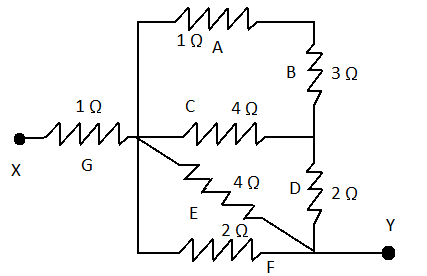Answer
64.8k+ views
Hint: Equivalent resistance of two resistances connected in series combination is equal sum of individual resistances. Multiplicative inverse of equivalent resistance of two resistances connected in parallel combination is equal sum of multiplicative inverse of individual resistance. Here to find equivalent resistance between X and Y, we divide the complete circuit in parts and solve the parts and combine them again.
Complete step by step solution:
Given, ${R_A} = 1\Omega $, ${R_B} = 3\Omega $, ${R_C} = 4\Omega $, ${R_D} = 2\Omega $, ${R_E} = 4\Omega $, ${R_F} = 2\Omega $ and ${R_G} = 1\Omega $.
First, we take ${R_A}$ and ${R_B}$, these are connected in series then their equivalent resistance is ${R_{AB}} = {R_A} + {R_B} = 1 + 3 = 4\Omega $.
Now, resistance ${R_{AB}}$ and ${R_C}$ are connected in parallel and their equivalent resistance is ${R_{ABC}} = \dfrac{{{R_{AB}} \times {R_C}}}{{{R_{AB}} + {R_C}}} = \dfrac{{4 \times 4}}{{4 + 4}} = 2\Omega $.
Now, ${R_{ABC}}$ and \[{R_D}\] are connected in series and their equivalent resistance is ${R_{ABCD}} = {R_{ABC}} + {R_D} = 2 + 2 = 4\Omega $.
Now, resistance ${R_{ABCD}}$, ${R_E}$ and ${R_F}$ are connected in parallel combination and their equivalent resistance is \[{R_{ABCDEF}} = \dfrac{1}{{\dfrac{1}{{{R_{ABCD}}}} + \dfrac{1}{{{R_E}}} + \dfrac{1}{{{R_F}}}}} = \dfrac{1}{{\dfrac{1}{4} + \dfrac{1}{4} + \dfrac{1}{2}}} = 1\Omega \].
Finally, we have two resistance \[{R_{ABCDEF}}\] and \[{R_G}\] connected in series and their equivalent resistance is ${R_{Eq}} = {R_{ABCDEF}} + {R_G} = 1 + 1 = 2\Omega $.
Hence equivalent resistance between X and Y is $2\Omega $ and the correct answer is option B.
Note: For better understanding we can assume that after every step combination of resistances is replaced by their equivalent resistance. After all steps we find that there is only one resistance between X and Y and this resistance is equivalent resistance of all resistances.
Complete step by step solution:
Given, ${R_A} = 1\Omega $, ${R_B} = 3\Omega $, ${R_C} = 4\Omega $, ${R_D} = 2\Omega $, ${R_E} = 4\Omega $, ${R_F} = 2\Omega $ and ${R_G} = 1\Omega $.
First, we take ${R_A}$ and ${R_B}$, these are connected in series then their equivalent resistance is ${R_{AB}} = {R_A} + {R_B} = 1 + 3 = 4\Omega $.
Now, resistance ${R_{AB}}$ and ${R_C}$ are connected in parallel and their equivalent resistance is ${R_{ABC}} = \dfrac{{{R_{AB}} \times {R_C}}}{{{R_{AB}} + {R_C}}} = \dfrac{{4 \times 4}}{{4 + 4}} = 2\Omega $.
Now, ${R_{ABC}}$ and \[{R_D}\] are connected in series and their equivalent resistance is ${R_{ABCD}} = {R_{ABC}} + {R_D} = 2 + 2 = 4\Omega $.
Now, resistance ${R_{ABCD}}$, ${R_E}$ and ${R_F}$ are connected in parallel combination and their equivalent resistance is \[{R_{ABCDEF}} = \dfrac{1}{{\dfrac{1}{{{R_{ABCD}}}} + \dfrac{1}{{{R_E}}} + \dfrac{1}{{{R_F}}}}} = \dfrac{1}{{\dfrac{1}{4} + \dfrac{1}{4} + \dfrac{1}{2}}} = 1\Omega \].
Finally, we have two resistance \[{R_{ABCDEF}}\] and \[{R_G}\] connected in series and their equivalent resistance is ${R_{Eq}} = {R_{ABCDEF}} + {R_G} = 1 + 1 = 2\Omega $.
Hence equivalent resistance between X and Y is $2\Omega $ and the correct answer is option B.
Note: For better understanding we can assume that after every step combination of resistances is replaced by their equivalent resistance. After all steps we find that there is only one resistance between X and Y and this resistance is equivalent resistance of all resistances.
Recently Updated Pages
Write a composition in approximately 450 500 words class 10 english JEE_Main

Arrange the sentences P Q R between S1 and S5 such class 10 english JEE_Main

What is the common property of the oxides CONO and class 10 chemistry JEE_Main

What happens when dilute hydrochloric acid is added class 10 chemistry JEE_Main

If four points A63B 35C4 2 and Dx3x are given in such class 10 maths JEE_Main

The area of square inscribed in a circle of diameter class 10 maths JEE_Main

Other Pages
A boat takes 2 hours to go 8 km and come back to a class 11 physics JEE_Main

Electric field due to uniformly charged sphere class 12 physics JEE_Main

In the ground state an element has 13 electrons in class 11 chemistry JEE_Main

According to classical free electron theory A There class 11 physics JEE_Main

Differentiate between homogeneous and heterogeneous class 12 chemistry JEE_Main

Excluding stoppages the speed of a bus is 54 kmph and class 11 maths JEE_Main




